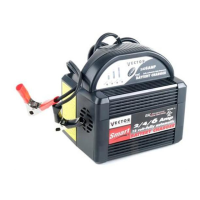
Do you have a question about the Vector VEC1086B and is the answer not in the manual?
| Type | Automatic Battery Charger |
|---|---|
| Battery Voltage | 6V/12V |
| Input Voltage | 120V AC |
| Input Frequency | 60Hz |
| Automatic Shutoff | Yes |
| Reverse Polarity Protection | Yes |
| Overcharge Protection | Yes |
| Output Current | 8A |
| Battery Type | Standard, AGM, Gel |
| Features | LED Indicators |
| Charging Modes | Automatic |
Highlights dangers of explosive gases during normal battery operation and stresses following instructions.
Ensures charger is used only for lead-acid batteries, not dry-cell types, to prevent damage or injury.
Instructs to take charger to a qualified technician if cord or plug is damaged.
Advises seeking qualified technician if charger is dropped, struck, or damaged.
Prohibits user disassembly; requires service from a qualified technician to avoid shock or fire.
Emphasizes unplugging the charger before maintenance or cleaning to reduce electric shock risk.
Prohibits operating the charger in rain, snow, or when wet to prevent electric shock.
Warns against charging batteries that are frozen, as this can cause damage or explosion.
Ensures someone is nearby and advises keeping soap and water accessible for acid contact.
Recommends eye protection and avoiding touching eyes/skin; provides first aid for acid exposure.
Instructs to wash skin or clothing immediately with soap and water if battery acid contacts them.
Strictly prohibits smoking or allowing sparks/flames near batteries or engines to prevent explosion.
Warns that dropping metal objects on a battery can cause sparks, short-circuits, and explosions.
Advises removing metal jewelry to prevent sparks, short-circuits, and severe burns from battery current.
Stresses the need for good ventilation around the battery during charging to disperse gases.
Never place the charger directly above a battery to prevent corrosion from gases.
Do not operate the charger in a restricted or non-ventilated area.
Connect and disconnect DC output clamps only after unplugging the AC cord from the outlet.
Never allow the DC output clamps to touch each other to prevent short circuits.
Attach clamps securely to battery posts to ensure a good connection and reduce sparking risk.
Explains common causes for the FAULT LED lighting up and their solutions.
